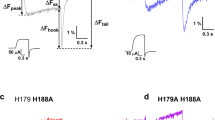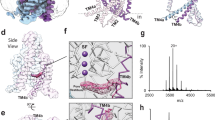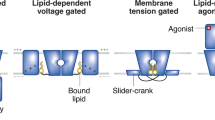Abstract
Cells communicate with their external environment through physical and chemical processes that take place in the cell-surrounding membrane. The membrane serves as a barrier as well as a special environment in which membrane proteins are able to carry out important processes. Certain membrane proteins have the ability to detect the membrane voltage and regulate ion conduction or enzyme activity1,2. Such voltage-dependent processes rely on the action of protein domains known as voltage sensors, which are embedded inside the cell membrane and contain an excess of positively charged amino acids, which react to an electric field. How does the membrane create an environment suitable for voltage sensors? Here we show under a variety of conditions that the function of a voltage-dependent K+ channel is dependent on the negatively charged phosphodiester of phospholipid molecules. A non-voltage-dependent K+ channel does not exhibit the same dependence. The data lead us to propose that the phospholipid membrane, by providing stabilizing interactions between positively charged voltage-sensor arginine residues and negatively charged lipid phosphodiester groups, provides an appropriate environment for the energetic stability and operation of the voltage-sensing machinery. We suggest that the usage of arginine residues in voltage sensors is an adaptation to the phospholipid composition of cell membranes.
This is a preview of subscription content, access via your institution
Access options
Subscribe to this journal
Receive 51 print issues and online access
$199.00 per year
only $3.90 per issue
Buy this article
- Purchase on Springer Link
- Instant access to full article PDF
Prices may be subject to local taxes which are calculated during checkout




Similar content being viewed by others
References
Sigworth, F. J. Voltage gating of ion channels. Q. Rev. Biophys. 27, 1–40 (1994)
Murata, Y., Iwasaki, H., Sasaki, M., Inaba, K. & Okamura, Y. Phosphoinositide phosphatase activity coupled to an intrinsic voltage sensor. Nature 435, 1239–1243 (2005)
Jiang, Y. et al. X-ray structure of a voltage-dependent K+ channel. Nature 423, 33–41 (2003)
Jiang, Y., Ruta, V., Chen, J., Lee, A. & MacKinnon, R. The principle of gating charge movement in a voltage-dependent K+ channel. Nature 423, 42–48 (2003)
Lee, S. Y., Lee, A., Chen, J. & MacKinnon, R. Structure of the KvAP voltage-dependent K+ channel and its dependence on the lipid membrane. Proc. Natl Acad. Sci. USA 102, 15441–15446 (2005)
Long, S. B., Campbell, E. B. & MacKinnon, R. Crystal structure of a mammalian voltage-dependent Shaker family K+ channel. Science 309, 897–903 (2005)
Long, S. B., Campbell, E. B. & MacKinnon, R. Voltage sensor of Kv1.2: structural basis of electromechanical coupling. Science 309, 903–908 (2005)
Jiang, Q. X., Wang, D. N. & MacKinnon, R. Electron microscopic analysis of KvAP voltage-dependent K+ channels in an open conformation. Nature 430, 806–810 (2004)
Campbell, R. B., Balasubramanian, S. V. & Straubinger, R. M. Phospholipid–cationic lipid interactions: influences on membrane and vesicle properties. Biochim. Biophys. Acta 1512, 27–39 (2001)
Jiang, Y. et al. Crystal structure and mechanism of a calcium-gated potassium channel. Nature 417, 515–522 (2002)
Israelachvili, J. N. Intermolecular and Surface Forces 2nd edn 366–394 (Academic Press, London, 1991)
Hui, K., McIntyre, D. & French, R. J. Conotoxins as sensors of local pH and electrostatic potential in the outer vestibule of the sodium channel. J. Gen. Physiol. 122, 63–79 (2003)
MacKinnon, R., Latorre, R. & Miller, C. Role of surface electrostatics in the operation of a high-conductance Ca2+-activated K+ channel. Biochemistry 28, 8092–8099 (1989)
Sun, T., Naini, A. A. & Miller, C. High-level expression and functional reconstitution of Shaker K+ channels. Biochemistry 33, 9992–9999 (1994)
MacDonald, R. C. et al. Physical and biological properties of cationic triesters of phosphatidylcholine. Biophys. J. 77, 2612–2629 (1999)
Ramu, Y., Xu, Y. & Lu, Z. Enzymatic activation of voltage-gated potassium channels. Nature 442, 696–699 (2006)
Freites, J. A., Tobias, D. J., von Heijne, G. & White, S. H. Interface connections of a transmembrane voltage sensor. Proc. Natl Acad. Sci. USA 102, 15059–15064 (2005)
Ruta, V., Jiang, Y., Lee, A., Chen, J. & MacKinnon, R. Functional analysis of an archeabacterial voltage-dependent K+ channel. Nature 422, 180–185 (2003)
Heginbotham, L., LeMasurier, M., Kolmakova-Partensky, L. & Miller, C. Single Streptomyces lividans K+ channels: functional asymmetries and sidedness of proton activation. J. Gen. Physiol. 114, 551–560 (1999)
Miller, C. Ion Channel Reconstitution (Plenum Press, New York, 1986)
Acknowledgements
We thank Y. Jiang for the MthK channel construct and A. Lee for the CTX. This work was supported by an NIH grant to R.M. R.M. is an investigator in the Howard Hughes Medical Institute.
Author information
Authors and Affiliations
Corresponding author
Ethics declarations
Competing interests
Reprints and permissions information is available at www.nature.com/reprints. The authors declare no competing financial interests.
Supplementary information
Supplementary Notes
This file contains the Supplementary Methods and the Supplementary Figures 1 and 2. The Supplementary Methods provide details on the experimental procedures. Supplementary Figure 1 shows a cryo-electron microscopic image of DOGS vesicles with reconstituted KvAP, demonstrating that under our experimental conditions DOGS forms normal bilayers. Supplementary Figure 2 shows KvAP in DOPA vesicles fused into a DOPA bilayer, demonstrating the importance of the phosphate headgroup for voltage-dependent channel function. (DOC 3672 kb)
Rights and permissions
About this article
Cite this article
Schmidt, D., Jiang, QX. & MacKinnon, R. Phospholipids and the origin of cationic gating charges in voltage sensors. Nature 444, 775–779 (2006). https://doi.org/10.1038/nature05416
Received:
Accepted:
Published:
Issue Date:
DOI: https://doi.org/10.1038/nature05416
This article is cited by
-
Tracking Membrane Protein Dynamics in Real Time
The Journal of Membrane Biology (2021)
-
Targeting inhibitory cerebellar circuitry to alleviate behavioral deficits in a mouse model for studying idiopathic autism
Neuropsychopharmacology (2020)
-
A PIP2 substitute mediates voltage sensor-pore coupling in KCNQ activation
Communications Biology (2020)
-
Identification of a molecular locus for normalizing dysregulated GABA release from interneurons in the Fragile X brain
Molecular Psychiatry (2020)
-
TRP Channels, Conformational Flexibility, and the Lipid Membrane
The Journal of Membrane Biology (2020)
Comments
By submitting a comment you agree to abide by our Terms and Community Guidelines. If you find something abusive or that does not comply with our terms or guidelines please flag it as inappropriate.



